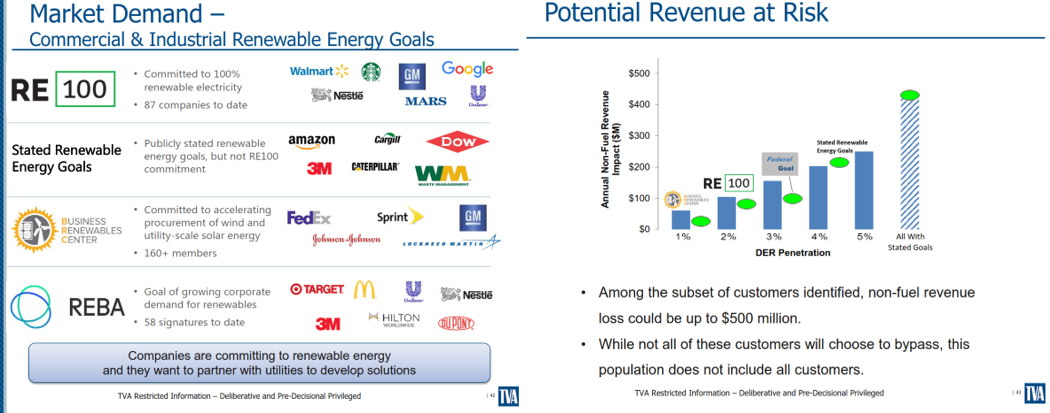This blog was written by John D. Wilson, former Deputy Director for Regulatory Policy at the Southern Alliance for Clean Energy.
Guest Blog | April 10, 2018 | Energy Policy, Tennessee, UtilitiesTVA has done it again. They’ve misled the public on a key economic decision. TVA has proposed a discriminatory rate structure change and is hiding its real intent in a desperate measure to limit new technologies and customer freedoms.
Public comments for TVA’s new Grid Access Charge policy proposal closed yesterday after just 30 days. Thanks to some Freedom of Information Act requests SACE filed, we were able to (mostly) unpack a confusing and misleading proposal. (You can read our comments here – they are 50 pages, plus supplementary material, so we hope you find them enlightening!) What TVA said in its “Environmental Assessment” differs dramatically from what TVA said behind closed doors.
Bottom line: TVA should withdraw the proposed Grid Access Charge. It is bad policy and will hurt customers. It runs counter to TVA’s mission. It will fail. Instead, TVA should work with Local Power Companies, businesses, and residential customers to embrace customer choice and control through solar, energy efficiency, storage, and electric cars.
Here’s what TVA wants you to believe:
- TVA is changing its rate structure to make sure all customers pay their fair share of costs.
- The impacts on residential customers will be small (just a dollar or so a month).
- It won’t have much affect on solar, energy efficiency, or the environment.
- TVA is still putting residential customers first.
Here’s what we found in an extensive review of TVA’s private communications with Local Power Companies and businesses.
- In a desperate attempt to protect its revenue, TVA is changing its rate structures to stop the military, federal agencies, and companies like Walmart, FedEx, and Hilton from installing solar power to help meet their business goals. It’s just another way that TVA is earning our “Sunblocker award.”
- TVA actually acknowledges that aligning its costs with rates would encourage customers to install solar, but designed the Grid Access Charge to undercut solar and energy efficiency deployment.
- TVA’s current proposal is only their first step – TVA plans to increase the Grid Access Charge in the near future.
- TVA’s contract terms will likely push Local Power Companies to use high mandatory fees to recover the charge. As a result, low income families will bear the brunt of the change. Low income customers could see their electricity bill suck away an additional 2.5% of their income, with unavoidable fees reducing their opportunity to use efficiency to cut household bills.
- TVA’s own documents show that TVA expects its proposal to cut customer-built solar by at least 40%, far more than the “minimal” impact TVA claimed in the “Environmental Assessment.”
- TVA is also cutting rates for large commercial customers on the backs of residential customers. This is after TVA already cut rates for industrial customers by about 20%, while raising rates for residential customers by about 5%.
This proposal could be TVA’s fifth policy change since 2010 and is another part of its emerging go-to tactic of shifting costs onto residential customers, discouraging energy efficiency and solar power, and shoring up political support from some of its large corporate customers. This is a short-sighted overreaction to those few customers – no more than 2% of TVA’s system – that are anticipated by TVA to invest in solar power. This proposal uses wholesale rates to shift more financial risk from TVA to Local Power Companies at a time that power sales are at risk of actually falling.
Yet TVA’s rate structure change will affect every TVA customer, and will harm the most vulnerable. On average, TVA’s lower-income customers use 10% less energy than higher income customers, and pay an average “energy burden” of 12.6% of household income towards their energy bills. If TVA implements the full Grid Access Charge, and LPCs continue covering these costs by increasing mandatory fees, then these lower-income customers will see their average energy costs rise to over 14% of household income.
SACE is joining with allied organizations, customers, and businesses to push TVA to withdraw the proposed Grid Access Charge. Instead, we are encouraging TVA to return to its mission that helped bring growth and prosperity to the Tennessee Valley. New, clean technologies and the freedom for customers to control their electricity options will make it happen. It must be a collaborative effort.
Want to know how this will affect your local power company’s rates? Here are some tables that spell out the specifics:
- Analysis of mandatory fees by local power company (LPC), and potential impact of TVA’s grid access charge (GAC) on those fees
- Analysis of TVA’s grid access charge and industrial rate shift on lower-income customers, by LPC
- Analysis of TVA’s industrial rate shift impacts on residential rates, by LPC
Our comments explain this in greater detail, but here are a few of the key documents that helped us understand TVA’s actual intentions.



